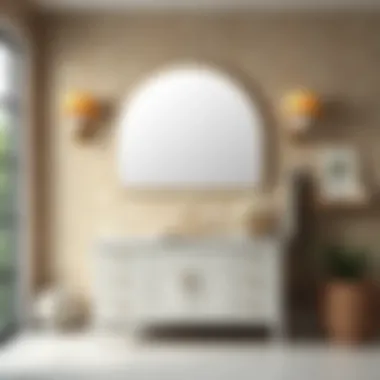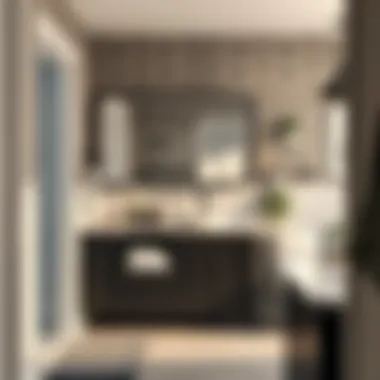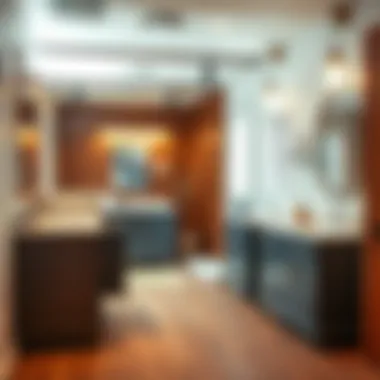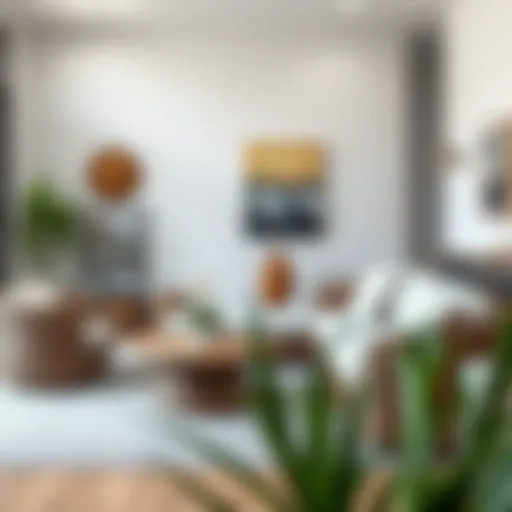Bathroom Vanities: Choosing 21-Inch Depth Solutions


Intro
When it comes to bathroom design, one of the unsung heroes often goes unnoticed: the vanity. A bathroom vanity isn’t just about functionality; it significantly contributes to the aesthetic appeal of the space. Among the myriad of options available, those with a depth of 21 inches stand out for multiple reasons. They strike a balance between compactness and usability, making them a suitable choice for both smaller spaces and more luxurious setups. This thorough guide will delve into various aspects of choosing the perfect 21-inch deep bathroom vanity, touching on design styles, maintenance instructions, and the latest trends that are redefining the realm of bathroom furniture.
Furniture Styles and Trends
Modern vs. Traditional: Understanding the Aesthetics
When selecting a bathroom vanity, one of the first decisions revolves around style. Modern designs often prioritize sleek lines, minimalist features, and a focus on natural materials. Woods like walnut or oak, paired with innovative finishes, can complement a contemporary bathroom beautifully. Conversely, traditional vanities embrace ornate designs, intricate carvings, and often heavier, richer materials like mahogany. These classic patterns can evoke a sense of nostalgia and warmth.
A few examples of modern styles include floating vanities, which give a room a sense of space and airiness, while traditional options may feature feet or bases that sit directly on the ground, creating a sturdy appearance. Choosing the right style may depend on the overall theme of your bathroom and your personal taste. It’s helpful to visualize how different styles impact the atmosphere of the space.
Color and Material Trends: What's In and What's Out
The color palette and materials used in bathroom vanities have seen a fair amount of evolution. In recent years, hues like navy blue and deep green have emerged as front-runners, providing a bold contrast against lighter wall colors. Additionally, natural finishes, such as raw wood, are gaining popularity, evoking a seamless connection with the outdoors.
When it comes to materials, solid wood remains a strong contender due to its durability and timeless appeal. However, alternatives like plywood and MDF are stepping into the limelight, offering more cost-effective yet stylish options. Ceramic and glass tops are also trending, giving the vanity an elegant finish while being easy to maintain.
"The right combination of color and material can turn even the simplest vanity into a standout feature of your bathroom."
Furniture Care and Maintenance
Tips for Prolonging the Life of Your Furniture
Purchasing a 21-inch deep vanity is just the first step. Maintaining its longevity requires some care and attention. Here are some tips that can help:
- Regular Cleaning: Use a damp cloth with mild soap to clean surfaces. Avoid harsh chemicals that can wear down finishes.
- Avoid Excess Water: Water exposure can damage wood and cause staining. Always wipe spills immediately.
- Sealant Application: For wooden surfaces, applying a sealant can help to protect against moisture damage.
DIY Repair Hacks for Common Furniture Issues
Despite best efforts, wear and tear can occur. Fortunately, many common issues can be addressed without requiring professional help. For example, loose knobs can usually be tightened using a standard screwdriver, and small scratches can be masked with a wood touch-up pen. Additionally, if the finish is wearing off, a light sanding followed by a layer of varnish can effectively revive its appearance.
Understanding both the aesthetic appeal and the practical aspects of furniture like bathroom vanities is essential for homeowners and designers alike. With the right care, a 21-inch depth vanity can serve as not just a functional piece but also a centerpiece that enhances your overall bathroom design.
Prelims to Bathroom Vanities
Bathroom vanities serve as the pivotal point in any bathroom, uniting function with form to create a space that is both practical and aesthetically pleasing. As a critical component in bathroom design, these fixtures combine storage, countertop space, and sink integration into a cohesive unit. In exploring bathroom vanities, especially those with a depth of 21 inches, it's essential to appreciate how these designs adapt to various bathroom styles and requirements. This depth strikes a balance between functionality and space, making it an obvious choice for many homeowners and designers.
Defining Bathroom Vanity
A bathroom vanity is essentially a combination of a sink and storage. It typically includes a countertop, a basin for washing, and cupboards or drawers for holding personal items. While traditional vanities were simply utilitarian, modern bathroom vanities embody a plethora of styles and finishes, catering to diverse tastes. They can range from rustic wooden designs to sleek, glossy models featuring intricate hardware. The beauty of a bathroom vanity lies not only in its practical within the bathroom but also in how it reflects the individual's aesthetic preferences.
Importance of Depth in Bathroom Vanities
When contemplating a bathroom vanity's depth, one must take into account how this measurement affects both the functionality and the overall flow of the space. A 21-inch deep vanity offers sufficient area for a variety of tasks while still fitting comfortably in most bathroom layouts. This depth is especially beneficial for compact bathrooms, where a deeper vanity can provide extra storage without overwhelming the area.
Here are a few points to consider regarding vanity depth:
- Storage Capacity: Deeper vanities can accommodate larger drawers and more shelving, which is vital for organized bathroom storage.
- Countertop Space: With more depth, there’s ample room for toiletries, decorative items, and even additional sink space if needed.
- Accessibility: For those who may have mobility challenges, a well-proportioned depth can enhance usability, making it easier to access items stored in the vanity.
In essence, the depth of a bathroom vanity plays a significant role in enhancing the function and design of the bathroom.
"The choice of bathroom vanity depth not only makes a statement but can transform the experience of using the bathroom into one that is more enjoyable and beneficial."
As we dive further into the nuances of 21-inch depth vanities, we will explore how dimensions, designs, and functionalities come together to create an ideal bathroom environment.
Understanding 21-Inch Depth Vanities
Bathroom vanities with a depth of 21 inches are not just about looks; they hold a significant place in optimizing space and enhancing the usability of a bathroom. These vanities strike a balance between compactness and functionality, making them suitable for various bathroom layouts, particularly in smaller spaces or powder rooms. Understanding the traits and advantages of opting for a 21-inch depth vanity can lead to a well-informed decision that harmonizes style with practical needs.
Ideal Dimensions for Space Management
When it comes to maximizing bathroom efficiency, dimensions matter substantially. A 21-inch depth vanity offers thoughtful proportions that fit snugly against walls without crowding the area. This depth enables adequate storage while still granting ample room for movement. Installers and homeowners alike often find that this dimension works well alongside standard 24-inch depth options, allowing for creative arrangements without turning the restroom into a maze.
Benefits of 21-inch depth vanities include:
- Enhanced Flow: Fitting well into tight spaces promotes ease of movement and accessibility.
- Optimal Storage: Despite the reduced depth, interior configurations can include deep drawers or shelves that don’t compromise on utility.
- Stylish Appeal: There are plenty of designs tailored to this specific depth that keep aesthetics front and center, offering contemporary and classic choices alike.
If your bathroom is petite, a 21-inch vanity might just be the golden ticket to making the most out of every inch.
Standard Variations in Bathroom Sizes
In the grand scheme, not all bathrooms share the same square footage. Traditionally, designs vary and can fall into categories of small, medium, or large bathrooms. Standard measurements often dictate what size fixtures like vanities should be for balance and proportion.
Here’s how the 21-inch depth vanity adapts to different spaces:
- Small Bathrooms: In compact settings, a 21-inch depth vanity is a fitting candidate. It can nestle into corners, creating a focal point without stealing the show.
- Medium Bathrooms: Here, versatility reigns. This size can complement a dual sink setup without overwhelming the existing layout, giving both function and aesthetic payoff.
- Large Bathrooms: While one might think of larger vanities in expansive bathrooms, strategically placing a 21-inch model can provide a contrast to add a layered effect in design.
Understanding the likely size of your bathroom will inform whether a 21-inch depth option is suitable, paving the way for a harmonious installation that doesn’t disrupt the existing flow.
"A well-planned space can make even the smallest bathroom feel luxurious and functional."
By recognizing the implications of space and dimensions, you arm yourself with the knowledge necessary to select a vanity that meets your personal requirements, ultimately turning the bathroom into not just a functional area, but also a refreshing sanctuary.
Design Considerations
When delving into the world of bathroom vanities, particularly those with a 21-inch depth, it becomes clear that design considerations play a pivotal role. The right vanity not only enhances the visual appeal of a bathroom but also improves its functionality, making thoughtful design choices essential. Factors such as style, color, material, and overall aesthetic can dramatically influence how the space feels and operates.


Styles and Aesthetics
Contemporary Designs
Contemporary designs capture the essence of modernity while emphasizing simplicity and functionality. A defining characteristic of these vanities is their clean lines and uncluttered forms. They often feature materials like tempered glass and metal, which lend a sleek, futuristic vibe to a bathroom.
The use of neutral colors such as whites, grays, and blacks can make the space feel more spacious, a significant benefit in smaller bathrooms. However, one unique feature that stands out in contemporary designs is the integration of technology; think built-in lighting for mirrors or heated surfaces. These additions enhance comfort and convenience but may lead to higher costs in both the initial purchase and maintenance.
Traditional Looks
On the other hand, traditional looks bring a sense of warmth and nostalgia to the bathroom environment. Often featuring ornate details like carvings and rich wood finishes, these vanities are designed to evoke a feeling of classic elegance. One key characteristic is the use of antique or vintage-styled hardware, which can add a charming touch.
What makes these vanities a beloved choice is their timeless appeal, ensuring they won't fall out of favor as trends change. However, the intricate designs can sometimes make cleaning a bit more cumbersome, which could be disheartening for those seeking low-maintenance solutions.
Minimalist Approaches
In stark contrast, the minimalist approach shines through its philosophy of "less is more." This design style emphasizes simplicity with clean surfaces and a lack of excessive ornamentation. A hallmark of minimalist designs is utility; every element serves a purpose, reducing distractions.
The starred feature of these vanities is their ability to create an airy, open feel in the bathroom. They can help foster relaxation by facilitating a clutter-free environment. Nonetheless, one potential drawback is that minimalism can sometimes come off as cold or uninviting if not carefully designed.
Color and Finish Choices
Timeless Shades
Timeless shades play a crucial role in bathroom design, presenting a versatile canvas for various styles. Commonly favored hues like beige, taupe, or soft greys tend to withstand the test of time. These colors go well with various decor elements, making it easier for homeowners to refresh their bathroom's look without frequently replacing the vanity.
A unique advantage of timeless shades is their complementary nature, allowing homeowners the freedom to switch up accents and accessories. However, on the flip side, they might lack boldness for those wanting something more vibrant.
Bold Colors
For the adventurous, bold colors can breathe life into a space. Imagine a striking cobalt blue or a vibrant emerald green vanity as a centerpiece. These shades serve to attract attention and evoke a sense of personality. The key characteristic of bold colors is their ability to create immediate visual impact, ensuring the bathroom is anything but dull.
However, a potential disadvantage is that bold colors may grow tiresome over time, making it essential to balance them with neutral elements. Swapping out accessories becomes a practical approach for those who appreciate change.
Eco-Friendly Finishes
Eco-friendly finishes represent a growing trend among homeowners conscientious about environmental impact. These finishes often use sustainable materials and low-VOC paints, emphasizing both beauty and sustainability. A hallmark of eco-friendly finishes is their commitment to health, providing a safer indoor air quality for families.
One unique feature is the variety of textures and appearances available, from reclaimed wood to bamboo options, which can blend seamlessly with various styles. While eco-friendly finishes can have a slightly higher initial investment, the long-term benefits, including durability and low maintenance, generally outweigh the costs.
By thoughtfully considering these design elements, individuals can achieve a bathroom that is not only stunning but also functional and aligned with their values.
"Design adds value faster than it adds costs, a must-remember mantra for every homeowner."
Through careful selection of styles, colors, and finishes, one ensures a cohesive and inviting bathroom environment.
Functionality Aspects
When it comes to choosing a bathroom vanity, functionality stands tall as a cornerstone of both design and utility. A well-planned vanity isn't just about good looks; it should also perform tasks seamlessly, accommodating everything from daily grooming routines to providing ample storage space. Understanding how various features of functionality play into the overall experience can make a significant difference in the satisfaction with your purchased vanity.
Storage Solutions
Drawers vs. Shelves
The ongoing debate between drawers and shelves in bathroom vanities is filled with practical considerations. Drawers, for instance, offer defined compartments that allow items to be organized neatly. They often have a smooth glide, enabling easy access to toiletries, towels, or any other bathroom essentials you might need without making a mess. On the flip side, shelves provide more flexible storage options, accommodating larger items like baskets or extra linens that might not fit easily in drawers. They allow you to see all of your items at a glance but can get cluttered quickly, making organization a bit of a puzzle.
The popularity of drawers often hinges on their ability to keep items concealed from view, providing a cleaner aesthetic in the styling of the vanity. This characteristic can be particularly beneficial in smaller bathrooms where space and visual clutter can feel overwhelming. However, choosing between the two can also come down to personal preference. A hybrid solution, where some components utilize drawers and others incorporate open shelving, often strikes a balance that suits many users' needs.
Innovative Storage Ideas
Going beyond traditional storage options, innovative storage ideas can serve as game-changers in maximizing functionality within a 21-inch depth vanity. Considering pull-out racks or built-in hampers can significantly enhance the usability of your space. Furthermore, utilizing vertical space by installing shelves above the vanity can keep essentials organized without sacrificing floor space. Hollistic designs might even include appliances’ nooks or hideaway charging stations for electric razors and toothbrushes, capitalizing on clutter-free aesthetics while providing practical convenience.
Creativity in storage solutions isn't just about efficiency; it can also offer a sleek look that aligns with modern bathroom trends. Such innovative options might be a bit pricier, but they can save you loads of frustration in the long run, creating organized spaces that reflect an air of sophistication.
Dual Sink Options
Having dual sink options can be a significant advantage, especially in larger households where time management matters. Installing a double vanity allows multiple users to access the sink simultaneously, streamlining morning routines and reducing bottlenecks. This consideration transitions from a mere luxury to a practical necessity in busy households.
Besides utility, dual sinks can enhance overall aesthetics. With configurations available in various styles, they contribute to a balanced and harmonious feel in the bathroom. However, it is essential to plan the plumbing carefully to avoid additional costs during installation. Ensuring sufficient space in a 21-inch deep vanity for pipes and plumbing is crucial to making the dual sink layout work smoothly.
In summary, functionality aspects for bathroom vanities encompass thoughtful consideration of storage solutions and layouts, catering to both practical demands and aesthetic goals. A well-chosen vanity can strike the right chord between efficiency and style, ensuring that your bathroom remains both practical and visually pleasing.
Essentials of Functionality: Choose designs that blend storage efficiency and aesthetic appeal to optimize your bathroom experience.
Material Options
When it comes to selecting the right bathroom vanity, the materials involved play a pivotal role in defining not only its aesthetics but also its functionality and longevity. For vanities featuring a depth of 21 inches, choosing appropriate materials can mean the difference between a mere fixture and a standout piece that meets all practical requirements while complementing your decor. Homeowners, designers, and DIYers should consider both the structural properties and overall appeal of various materials to make informed decisions.
Wood Varieties
Solid Wood Benefits
Solid wood, a classic choice in cabinetry, offers unparalleled durability and withstands the test of time. It's often considered the gold standard for bathroom vanities. The strength of solid wood allows it to endure moisture better than some composite materials, provided it is well-sealed. One of the key characteristics of solid wood is its rich grain and texture, which adds warmth to any bathroom space. Plus, it can be sanded and refinished if it shows signs of wear, making it a sustainable option in the long run.
However, solid wood also comes with some downsides; it can be quite heavy and typically requires sturdy installation. Additionally, the cost tends to be higher compared to other materials. Still, the benefits often outweigh the costs, especially for those seeking a stylish yet resilient vanity solution.
MDF and Plywood


MDF (Medium Density Fiberboard) and plywood represent popular alternatives to solid wood, each with distinct advantages. MDF, made from wood fibers bonded together, is a great choice for intricate designs and painted finishes. Since it has a smooth surface, it's easy to paint and can be made to look more luxurious than its cost might suggest. Plywood, being more stable than solid wood, tends to resist warping better in humid environments. However, it may not stand up to heavy wear and tear as effectively as solid wood, especially if not properly treated.
Countertop Materials
Quartz
Quartz countertops, engineered from natural stone crystals, deliver a balance of beauty and practicality for bathroom vanities. One of the standout features of quartz is its non-porous surface, which makes it resistant to staining and bacteria growth—ideal for spaces prone to moisture. The variety of colors and patterns available means you can find something that fits your design aesthetic perfectly.
However, it's worth noting that while quartz is robust, it can be sensitive to heat. Placing hot objects directly on its surface may cause damage. Nonetheless, for homeowners focused on hygiene and style, quartz remains a strong contender.
Granite
Granite boasts its own set of unique strengths, primarily its natural beauty and unparalleled durability. Each slab is distinct, adding a unique touch to any bathroom vanity. Its heat-resistant properties are a significant advantage, making it ideal for anyone who uses hot styling tools frequently. Granite does require regular sealing to maintain its resistance against moisture and stains, but when cared for properly, it can last a lifetime.
On the flip side, granite can be heavier and might demand professional installation to ensure it is properly supported and adequately finished. But for those looking for elegance and robust functionality, granite may just be the answer.
Laminate
Lastly, laminate countertops are a budget-friendly option that can imitate the look of more expensive materials while offering modest durability. The key characteristic of laminate is its extensive range of designs—from wood grain to vibrant colors—allowing homeowners to customize their vanities at a lower cost. It's lightweight and easy to clean, making it a practical choice for those familiar with high-traffic bathrooms.
While laminate doesn’t match the longevity of granite or quartz, its affordability makes it attractive for those working with tight budgets or looking for a temporary solution. However, it can be damaged by excessive heat and moisture, which is where careful planning comes in.
When choosing materials for a 21-inch vanity, weigh the pros and cons carefully, keeping in mind both aesthetic appeal and functional characteristics.
Exploring these material options equips homeowners and designers alike with the knowledge to create vanities that support both daily use and long-term satisfaction. You can find more about these materials at reputable resources like Wikipedia or design sites like Britannica.
Installation Considerations
When it comes to bathroom vanities with a depth of 21 inches, installation is a crucial element that shapes the overall effectiveness and aesthetic of the bathroom space. Although selecting the right vanity can be a challenge, understanding installation considerations provides clarity and helps in making informed choices. Whether you are a seasoned DIY enthusiast or leaning toward professional help, evaluation of installation factors can save time, energy, and ultimately, money.
DIY vs. Professional Installation
Choosing between a do-it-yourself (DIY) approach and professional installation is often the first hurdle faced by homeowners. DIY installation of bathroom vanities is attractive for many; it adds a personal touch to the bathroom and can help save on service costs. However, it’s essential to weigh the skills required against availability of time and tools.
- Skill Level: If you're handy and have experience with plumbing and carpentry, a DIY approach might work well.
- Tools Required: It's important to have access to the right tools. Some tasks may require specialized equipment that could add to your costs if you need to rent or buy supplies.
- Time Investment: Installing a vanity can take longer than expected, especially if complications arise. You need to be prepared for setbacks and unforeseen issues.
On the flip side, hiring professionals can alleviate stress. They bring experience and expertise, which can be particularly vital when dealing with plumbing and electrical components, ensuring that everything is installed correctly and safely. The cost might be higher upfront, but it reduces the risk of errors that could turn into expensive repairs later on.
Plumbing and Electrical Considerations
Proper plumbing and electrical work are the backbone of any bathroom renovation. When installing a 21-inch deep vanity, paying attention to the plumbing setup is a must to avoid future headaches.
Key Plumbing Aspects:
- Water Supply Lines: Ensure that your water supply lines are compatible with the new vanity. It may involve adjusting or rerouting existing pipes.
- Drainage System: Check the drainage alignment. The vanity’s position might require some plumbing adjustments to ensure proper drainage, preventing water flow issues or leaks.
Electrical Elements:
- Sconces and Lighting: Consider where you want to place lighting fixtures. Proper electrical connections can enhance the functionality of the space and improve it visually.
- Outlet Placement: If the vanity is used for grooming or hair styling, incorporating electrical outlets within proximity is practical but must adhere to safety codes.
These elements may seem minor, yet they can significantly affect both usability and safety in your bathroom. Taking the time to assess your plumbing and electrical needs with diligence can contribute favorably to the longevity of your bathroom vanity setup.
In short, whether choosing DIY or professional installation, understanding plumbing and electrical considerations can make or break the success of your bathroom renovation.
By paying keen attention to these factors, homeowners can ensure that their 21-inch depth vanities not only fit aesthetically but also function optimally within the space.
Current Trends in Bathroom Design
Staying in tune with current trends in bathroom design is essential for homeowners and professionals alike, especially when it comes to selecting vanities that not only fit the dimensions of the space but also complement the overall aesthetic. The bathroom, often considered a personal oasis, is evolving into a multifunctional space, reflecting the taste and lifestyle preferences of its users. This section delves into two of the most notable trends shaping modern bathroom vanities: sustainable materials and smart technology integrations. Both elements are not just passing fads; they offer significant benefits in terms of longevity, utility, and environmental responsibility.
Sustainable Materials
In recent years, the shift towards sustainability has infiltrated various aspects of home design, with bathroom vanities being no exception. More manufacturers are now utilizing eco-friendly materials, which are sourced responsibly and designed to minimize environmental impact. Here are some popular options:
- Recycled Wood: Using reclaimed wood not only adds character to a vanity but also helps reduce deforestation.
- Bamboo: This fast-growing plant is durable and renewable, making it an excellent material choice.
- Low-VOC Finishes: Traditional varnishes and stains often contain harmful chemicals. Opting for low-VOC (Volatile Organic Compounds) options contributes to better indoor air quality.
Choosing sustainable materials often leads to high-quality products that stand the test of time. The added bonus is that homeowners can feel good knowing they are making environmentally friendly choices. As consumers increasingly prioritize sustainability, brands that emphasize eco-friendly options may stand out in a crowded market, thus affecting purchasing decisions.
"Sustainability starts at home. Each choice we make in our bathrooms can contribute to a much larger dialog about our planet's future."
Smart Technology Integrations
As technology becomes more embedded in our daily lives, integrating smart technology into bathroom vanities is gaining traction. From automatic faucets to built-in LED lighting, the goal is to enhance comfort and functionality. Here’s a quick look at some smart features you might consider:
- Touchless Faucets: These faucets not only save water but also reduce the risk of germ transmission since there's no need to touch a handle.
- LED Touch-Control Lighting: Adjustable lighting is essential for various tasks, and smart controls allow users to modify their bathroom ambiance easily.
- Smart Mirrors: Some mirrors come equipped with built-in lighting, defoggers, or even Bluetooth speakers, turning a simple reflection surface into an all-in-one tech hub.
Integrating technology into bathroom design isn't just about convenience; it also enhances user experience. Smart features can lead to water savings and energy efficiency, appealing to the environmentally conscious homeowner. As we look to the future, the fusion of aesthetic elements with advanced technology may very well redefine how we interact with our bathrooms.
Both sustainable materials and smart technology mark a significant shift towards a more conscious and connected approach to bathroom design. As these trends continue to grow, they bring with them opportunities for innovation and improvement in both aesthetics and functionality.
Purchasing Considerations
When it comes to bathroom vanities, specifically those with a depth of 21 inches, there are several purchasing considerations that one ought to bear in mind. These factors not only influence the aesthetic appeal of your bathroom but also determine how functional and durable your choice will be. Understanding the nuances of budgeting and evaluating the quality of materials can save a homeowner from a world of headaches down the road.
Budgeting for Bathroom Vanities
Setting a budget is the first step in purchasing any home improvement item, and bathroom vanities are no different. Determine how much you are willing to spend on a new vanity while keeping in mind that quality varies widely across different price points. A budget helps filter choices and narrows down the options to what is feasible.


Things to consider:
- Price Range: Low-end vanities may be tempting but often sacrifice durability. Mid-range options usually provide a balance between quality and affordability. High-end vanities offer premium materials and intricate designs, but they come at a cost.
- Installation Costs: Don’t just focus on the price of the vanity itself. Sometimes the installation can add a significant amount to the overall price. If you choose to go the DIY route, factor in the cost of tools and any additional materials.
- Long-Term Investment: Consider the longevity of the vanity. Spending a bit more upfront might save you from replacing it sooner than later. A sturdy vanity can enhance your bathroom's resale value, which is worth considering if you may sell your home in the future.
Evaluating Quality and Longevity
The quality of the materials used in your bathroom vanity plays a pivotal role in its lifespan and durability. When evaluating a vanity, scrutinize its components, including the frame, countertop, and hardware. This can help prevent dissatisfaction later on.
Warranties
A strong warranty on a bathroom vanity signifies manufacturer confidence in its product. When companies offer extended warranties, they usually stand behind their craftsmanship. Generally, a warranty covers defects in materials and workmanship, which means if your vanity falls apart due to manufacturing flaws, you have a safety net.
Key Characteristics of Warranties:
- Typically ranges from one year to lifetime coverage.
- Can cover different components separately (like countertops vs. hardware).
Advantages of Warranties:
- Peace of mind that defects are handled without additional cost.
- Potential savings in repairs or replacements down the line.
Disadvantages of Warranties:
- Often limited by certain conditions like improper installation or misuse.
- Replacement parts might be hard to find if a product is discontinued.
Brand Comparisons
Selecting the right brand is essential for ensuring quality. Each company has its reputation and level of craftsmanship, which can greatly influence your purchase decision. Some brands are renowned for their durability and design, while others might fall short after a few uses.
Key Characteristics of Brand Comparisons:
- Established brands often come with a track record of customer satisfaction and reliability.
- Newer entrants may offer innovative features but lack the history of durability.
Advantages of Brand Comparisons:
- Insight into customer reviews and testimonials helps you gauge product reliability.
- Established brands may provide better warranty options and customer service support.
Disadvantages of Brand Comparisons:
- Brand loyalty can limit your options and sometimes lead to overspending.
- Not every high-priced brand guarantees the best quality, so thorough research is necessary.
In summation, purchasing a bathroom vanity with a depth of 21 inches calls for careful planning and consideration. Balancing budget constraints with quality evaluations can yield a wise investment that enhances your bathroom for years to come.
The End
As we bring this exploration to a close, it's crucial to reflect on the significance of 21-inch depth bathroom vanities. Understanding this specific dimension is no trivial task; it encompasses essential factors that every homeowner and designer must consider when revamping a bathroom. These vanities are not just about aesthetics; they play an important role in optimizing functionality and managing space effectively.
Key Takeaways:
- Space Efficiency: A 21-inch depth vanity strikes a balance between offering sufficient workspace and maintaining a compact footprint, especially valuable in smaller bathrooms.
- Design Options: With an array of styles available, from sleek modern looks to classic designs, these vanities cater to diverse taste preferences without overwhelming the space.
- Practical Considerations: When selecting a vanity, it's imperative to consider storage solutions and material durability as they directly impact the functionality of your bathroom.
The depth also has implications on overall visibility; a well-placed vanity can enhance the perception of space and light, thus uplifting the entire bathroom ambiance. This factor becomes more pronounced in smaller areas, where strategic placements can create a sense of openness.
"In bathroom design, every inch counts. A well-thought-out depth can significantly impact the efficiency and comfort of your space."
Final Thoughts on 21-Inch Depth Vanities
Ultimately, the 21-inch depth vanity serves both form and function. It invites consideration not merely of aesthetic beauty but of practical approach towards design and usability. As you sift through your options, keep in mind the dual role these fixtures play in enhancing your bathroom's functionality while contributing to its overall charm. A well-selected vanity can make the daily routine a touch more pleasant, offering both storage and a stylish touch. For those delving into renovations or new constructions, prioritize thoughtful selection when it comes to your vanity; it’s a decision that pays dividends in comfort and visual pleasure.
Further Reading and Resources
In the world of bathroom design, knowledge is power. Understanding where to find credible and detailed information about 21-inch depth vanities can profoundly impact your decision-making process. This section offers a roadmap to some of the most relevant resources, enabling homeowners, designers, and DIY enthusiasts to make informed choices as they explore their options.
Recommended Websites
Interior Design Blogs
Interior design blogs are a treasure trove of information and inspiration. They allow readers to explore various styles, layouts, and design tips tailored to different tastes and budgets. A key characteristic of these blogs is their ability to showcase the latest trends and ideas through visual content and practical advice. The best interior design blogs often feature real-life projects, offering a glimpse into how 21-inch depth vanities can enhance a space.
Benefits:
- Visual Inspiration: Many blogs are rich in imagery, providing visuals that can stir creativity.
- Expert Opinions: They often include insights from seasoned designers and decorators, sharing nuanced tips and case studies related to bathroom vanities.
However, it's important to sift through a variety of sources, as not all blogs maintain the same level of credibility or depth in content. A blog that excels in showcasing aesthetics may offer less practical advice on functionality, making it essential to find a balance.
DIY Forums
DIY forums present a grassroots approach to bathroom design and renovation. Users share their first-hand experiences and insights, which can be remarkably beneficial for those considering a hands-on project. The essence of DIY forums lies in community knowledge; members collaborate to troubleshoot issues, share photos of their projects, and offer tips that might not be found in traditional publications.
Benefits:
- Practical Insights: Users often document their renovation journeys step-by-step, providing real-world solutions and advice.
- Community Support: Engaging with others who have similar interests fosters a sense of camaraderie and shared learning.
On the flip side, the unfiltered nature of forums means that the accuracy and quality of information can vary widely. Billions of opinions can lead to confusion if one isn’t able to discern which advice is reliable.
Books on Bathroom Design
Books focused on bathroom design can be invaluable. They often delve deep into both fundamental principles and cutting-edge ideas. For example, one might explore comprehensive texts that discuss the fundamentals of layout and aesthetics while also saving room for innovative trends.
Additionally, books usually contain detailed discussions on materials, maintenance, and case studies of well-executed designs. They provide a wealth of knowledge that can supplement information from less formal sources.
Whether you’re flipping through pages in search of aesthetic ideas or diving into technical details about installation processes, books can serve as a solid foundation in your bathroom design journey.
For further reading or sourcing additional inspiration, you might consider visiting well-respected sites such as:
These platforms can lead you down a rabbit hole filled with even more resources to inform and enhance your understanding of bathroom vanities and design.















